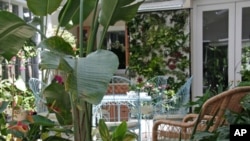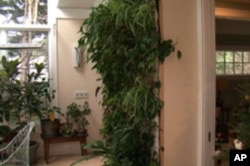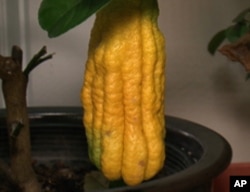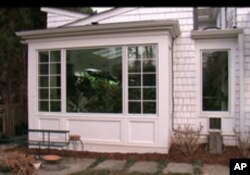It’s a cold winter day and Ruth Kassinger is eating fresh kumquats that she’s just picked from a tree inside her suburban Washington home. The kumquat is among a variety of tropical plants in the sunroom Kassinger calls her conservatory.
A chance visit to the National Botanic Garden in Washington gave her the idea to build her more modest version. "I walked in and the glass doors opened and I stepped into a beautiful green lush, warm and humid jungle, and I walked around for a while, and was just stunned by how beautiful and full of life this place was."
Kassinger wanted a place of refuge, where she could heal after her sister’s untimely death and her own recent bout with breast cancer. But getting started presented some hurdles.
"I hated gardening," she says. "I really hated the bugs and oppressive summer humidity in Washington.”
The solution was simple: she would grow plants indoors in pots.
In place of a worn backyard deck, Kassinger built a room with tall windows. She installed ceiling skylights, overhead fluorescents and heat lamps. A small exercise pool could also provide needed humidity. Gradually, Kassinger began filling the new room with orange, lime and lemon trees and an unusual yellow citrus with tentacle-like fingers called a Buddha’s Hand. "I like the idea of them being useful plants as well as beautiful plants," she says.
In contrast to her husband’s dormant vegetable garden, the fragrance of orange blossoms ensures it is always spring in the conservatory. Kassinger tends a dense array of ferns, thick, leafy plants and red heart-shaped flowers with tall spikes, native to tropical jungles.
One wall is covered by dozens of small foliage plants growing hydroponically between thin layers of synthetic felt. Kassinger says this floor-to-ceiling garden is watered by a fountain pump attached to a hose that runs across the top of the wall.
"And the water trickles down four times a day. It’s really great for a lazy gardener as I am because you really don’t have to do anything other than once a week, add more water and fertilizer to the trough."
Kassinger says her conservatory has grown in unexpected ways. She had envisioned a space where she could be cocooned from decline and loss, but it evolved into something quite different.
"Once we had the conservatory, we moved a kitchen table in there and now we eat all of our meals in the conservatory. This Garden of Eden for me did show me that the real joy of life is not to be isolated by myself without my family and friends."
Rather, Kassinger says, it is to be connected with people she loves.
Today, in that paradise, she is having a cup of tea with her youngest daughter Alice, home from college on vacation. The green world around them has become a part of their everyday lives.
"A conservatory never stands still. Plants are always growing. They are in some phase of their development. They are either fruiting or flowering. A conservatory can be a metaphor for life."
Kassinger says her Garden of Eden reminds her every day that she can live with life’s inevitable losses, both large and small. She weaves her story into a book on the history of conservatories called "Paradise under Glass." She writes, "A real paradise is not a quiet, immutable refuge, but a place where there is always something new under the sun."
















